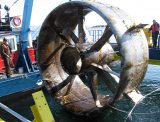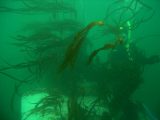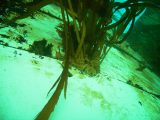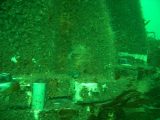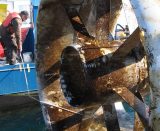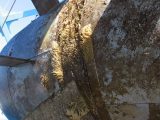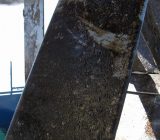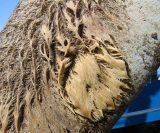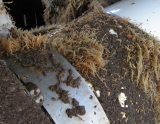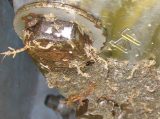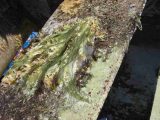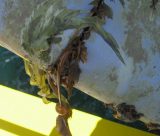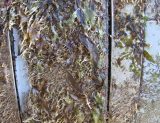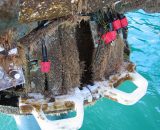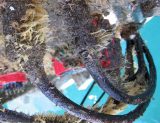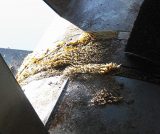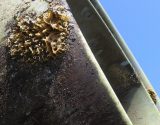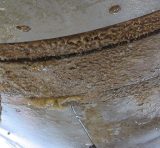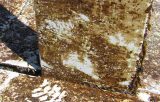A week before raising the turbine in April 2007, the outer Nereocystis growth was removed by the Pearson College Divers. Since the top of the turbine is in a water depth averaging 10 metres it is shallow enough for the brown Macroalgae to take foothold and within a few weeks it would have reached the surface. This algae can atttach to a solid substrate within the top 12 metres of water at Race Rocks.
- In April, 2007, the turbine was pulled up for inspection and possible refit of bearings.
- Growth of this macroalgae starts in March and had already reached several metres in height
- The kelp holdfasts were attached to the outer cowling on irregularities on the surface.
- A felt-like growth of algae and hydroids has already covered the flange below the turbine.
- It gave us an opportunity to examine the distribution of the species and level of growth of the fouling organisms.
- It also provided evidence of which materials are best in repelling growth
- . Many areas were completely covered with encrustations of diatoms or hydroids. This is one of the blades of the turbine.
- A scrape on the blade shows the thickness of the diatoms.
- These hydroids are likely the species Plumularia lagenifera
- All hydroids were of the order Leptothecatae with no Anthoathecatae observable.
- As in other instances we have experienced when there was long term deployment of instruments at Race Rocks, colonies of skeleton shrimp, shown here, cover some surfaces, and cling to the hydroid colonies.
- Skeleton shrimp (Caprella laeviuscula) hang from their rear appendages in this enlarged photo of a bolt head.
- Various species of red and brown algae ( Laminaria sp ) starting to grow, with more skeleton shrimp scattered throughout
- The turbine was too deep for the growth of green algae. These brown algae, Desmarestia sp. were attached to a blade. They appear green since they have been drying out for some time and the acids in the lamina tend to speed deterioration of pigment
- A few small bull kelp, (Nereocystis leutkeana) have anchored to the structure. This could provide problems for future entanglement if these kelp thrive on the structure.
- A mixed population of some red and brown algaes.
- In the areas underneath the structure where the cables attach, a good amount of protection is available thus encouraging the attachment of the fouling species.
- A 1 cm diameter barnacle has attached to this part of the structure. Note also skeleton shrimp.
- It demonstrated the problem of having any small crevice or location where organisms could establish a foothold on the structure.
- Hydroid clump on the underside of the cowling.
- Colonial Tunicates, the gelatinous yellow mass along one seam, have started to colonize in this area.
- Diatoms coat many of the exposed surfaces. They are usually the precursor to futire invertebrate growth..
Thanks to Russell Stothers of Clean Current and the Pearson College Divers for these images.

